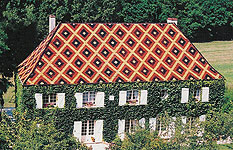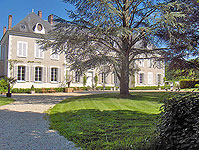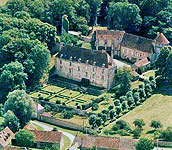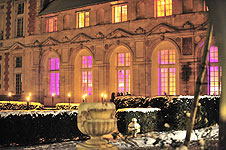 |
| The Independent Traveler's Newsletter PAGE FIVE |
 |
| The Independent Traveler's Newsletter PAGE FIVE |
| Beautiful Burgundy Revisited ~ Part One of Two |
|
We will
explore Burgundy in this issue and the next, concentrating first on two
The region officially known as Burgundy is a name taken from the Germanic tribe of long ago resident and rulers, the Burgundiones. They were followed centuries later by the Dukes of Burgundy whose realm was larger than that of France. The merger of the two, with France as the ruling partner, came in the 15th century. France benefited greatly from this marriage, gaining the lush landscape dotted with vineyards, renown today for its gourmet dining establishments offering such dishes as boeuf bourguignon, coq au vin, and rich repas that begin with a platter of locally-raised escargot. Beyond food and drink, however, Burgundy offers a wealth of Romanesque architecture and pleasing scenic drives along meandering and peaceful country roads. In the département of Yonne (89) Auxerre, which has long been considered the traditional capital of Burgundy, is a pretty little city straddling the banks of the River Yonne. You can visit the Gothic cathedral, Cathédrale St-Etienne, completed in 1560 after 300 years of construction, on the site of a Roman church that had been built over four earlier churches, the first of which date back to the 5th century. St-Etienne has dramatic flying buttresses and a western façade adorned with Flamboyant sculpture, as well as glorious stained glass windows dating from the 13th century. A short walk north on rue Cochois is the Abbaye St-Germain on place St-Germain. The abbey has a rich history that began in the 5th century - the Bishop of Auxerre, Saint Germain, was honored by the Queen for converting France to Catholicism. As a result, she had a basilica built in his name. Later a college was founded, and construction and reconstruction of the monastery continued off and on from the 12th through the 19th centuries. Don't miss the 11th century (Carolingian era) French frescoes, one of which depicts the martyr, Saint Etienne, being stoned at the wall of Jerusalem. Before leaving the Abbaye, do take the time to visit Le Musée Saint-Germain to experience its collection of prehistoric and Gallo-Roman archaeological treasures. The museum also houses paintings and sculpture from the 15th to 20th centuries. But what we found best of all was the time spent with a docent, speaking to us in French, who slowly and patiently explained the model of ancient Auxerre. She told us about the archaeological dig that took place in 1799 and the resultant discovery of the 1st century artifacts that filled the room. Her time with us made our visit unforgettable.
Other
places you might consider visiting in the Yonne département is
the little town of Sens (try the orange caramels), the orchards and meadows
of La Puisaye for biking, Chablis to experience its white wine and narrow
cobbled streets, Tonnerre with its Hôtel Dieu built 150 years earlier
than the one in Beaune, or the fortified village of Avallon. Discover
the back roads and hidden villages for yourself.
In the Côte d'Or (21) département, the Hospices de Beaune, Hôtel-Dieu, dates from the Middle Ages, having been built in 1443 by Nicolas Rolin, Chancellor of Philippe-de-Bon, Duke of Burgundy. Following the Hundred Years War with England, Beaune was steeped in poverty and famine. A full 75% of the townspeople were without provisions. The Chancellor and his wife, Guigone de Salins, founded the Hospice for the Poor (Les Pôvres). The couple provided it with an annual income, vines and a salt works, hiring many artists for its decoration.
Inside, visitors will find a wood sculpture of Christ carved from a single tree, the Great Hall of the Poor with each sleeping area curtained off in rich red fabric, a chapel in the Great Hall to allow patients to participate in Mass, the Pharmacy containing early medications for the afflictions of the day, a kitchen, the Saint Louis Room which served as a wine-fermenting room and bakery, and more. Today, the Hospices manage 57 hectares of vineyards that they have inherited over the centuries, and conduct their famous wine auction each November. Also worth your time in Beaune is a visit to the magnificent Ancient Collegiate Church of Notre Dame, inspired by Cluniac (Cluny) architecture. It is quite bright and beautiful inside. For an interesting look into the history of wine making, a short walk from the church on rue d'Enfer is the former home of the Ducs de Bourgogne, today the Musée du Vin. Guided tours are given at the wine museum, or you can visit the exhibits on your own. The collection illustrates the history of wine making from ancient times to the present day, showing the work of both the wine grower and the cooper. There is a tapestry by J. Lurçat that you won't want to miss. The museum is open daily April through November, and closed Tuesday from November to March. Also in Beaune is the Musée des Beaux Arts in the Hôtel de Ville, open the same days of the year as the wine museum. The time period covered in the collections is from the 15th through the 19th centuries, including many works from the Flemish School.
Dijon, the capital of the Côte d'Or, is a large city offering many tourist attractions, among them the Musée des Beaux Arts in the Palais des Ducs, the Gothic Eglise de Notre Dame, the Cathédrale de St-Michel, Musée Magnin, the Cathédrale St-Benigne and the Eglise St-Etienne. The churches and cathedrals of France are as much great examples of architecture and repositories of superb art as they are religious buildings. Dijon has many fine restaurants, so you probably will have no difficulty locating a good spot for an evening meal. Although the city is known for its mustard and caississines (black currant specialties), try to sample its other specialty: honey spice cakes known as pain d'épices. This is a tradition from Dijon's position on the spice route in earlier times. Today, the Canal de Bourgogne runs right through Dijon.
Other
noteworthy stops in the Côte d'Or are Châteauneuf en Auxois,
Alise-Ste-Reine the site of Caesar's victory in 52 BC, Musée Alésia
housing associated archaeological relics, and Flavigny sur Ozerain - the
location setting for the film 'Chocolat' staring Juliette Binoche, Johnny
Depp, and Judy Dench. Of course, there are ample vineyards for visits
and wine tastings throughout the region. One of our favorite places
and of special note is Abbaye de Fontenay, founded in 1118 by St
Bernard, the oldest Cistercian foundation in France. Surviving its
use as a paper mill between the French Revolution and its sale in 1906,
the abbey is once again in its original state. The Cistercian monks
took vows of poverty and the order grew to one of the largest of the time.
The cloisters and abbey church are simple in their Romanesque architecture,
symbolic of the Cistercian way of life. The site also had a prison
for local criminals under the abbot's jurisdiction, a scriptorium, a chapter
house and an herb garden providing plants by which the monks created their
healing medicines.
Look for
our visit to the Nievre and Saône-et-Loire départements in
Where to stay:
  
Le Petit Manoir des Bruyères Château de Chorey Château de la Resle
 
SPONSORING THIS ISSUE After
you've
read the articles about Lyon in the Rhône or Burgundy or are planning
|